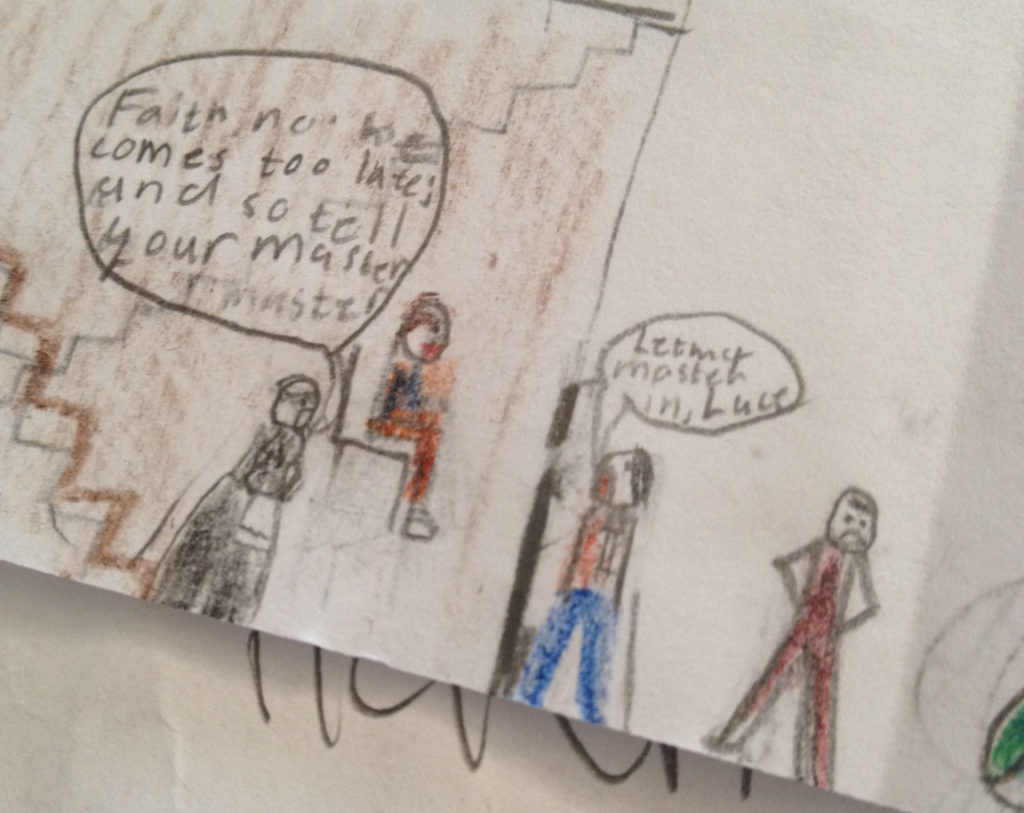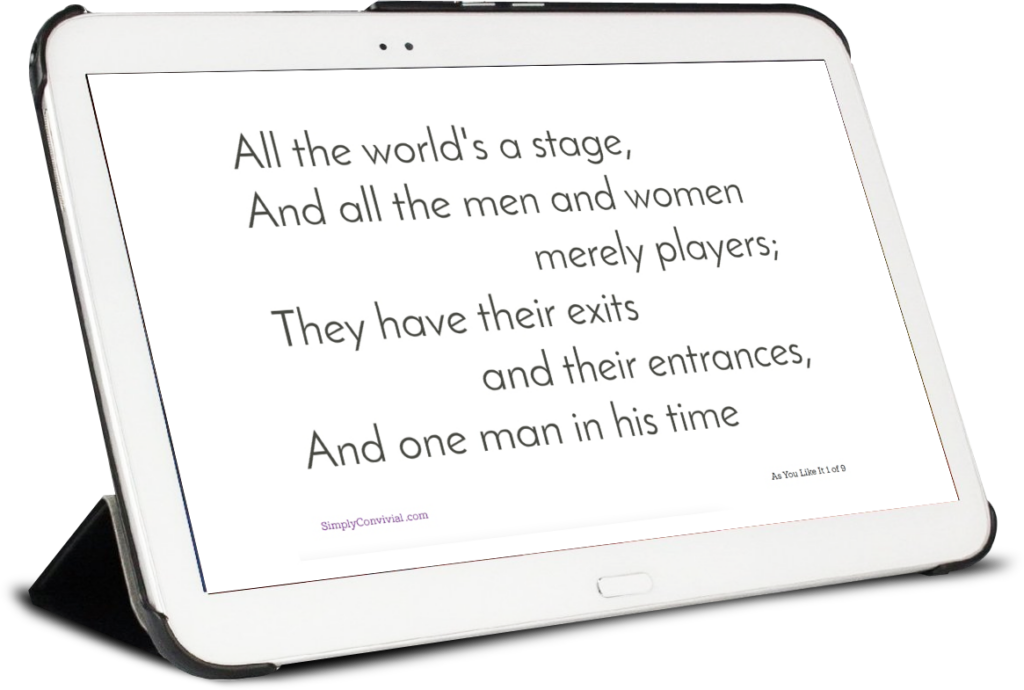The Comedy of Errors is a great play for kids who might be skeptical about Shakespeare. Full of slap-stick humor, over-the-top coincidences, and witty one-liners, Comedy of Errors is more about the laughs than the romance. Plus, it has one added benefit: it’s a very short play.
If you’ve tried Shakespeare with your kids in the past but have found your crowd to be particularly tough or your own enthusiasm to be low, try Comedy of Errors – the numerous Shakespearean insults are enough to win anyone over.
Follow these 5 simple steps to fall in love with Shakespeare with your kids:
1. Introduce The Comedy of Errors
The plot in Comedy of Errors revolves around the mistaken identity of two sets of twins. It’s a little tricky to keep track of who’s who, but that’s as true for the characters in the story as it is for the readers – in this play, that’s all part of the fun.
Introducing the tale with a well-told children’s version will help not only the kids, but even the teacher, keep track of the back-and-forth of mistaken identity.


2. Memorize Lines from The Comedy of Errors
Far from drudgery, memorizing lines from the Shakespeare play you’re reading cultivates affection and familiarity in kids. They start to own those lines and light up when they hear “their” part in the production or text.
When we studied The Comedy of Errors, I chose these lines for our memory work:
A wretched soul,
bruis’d with adversity,
We bid be quiet,
when we hear it cry;
But, were we burden’d with like weight of pain,
As much or more
we should ourselves complain.
and
Every why hath a wherefore.
Sign up and get instant access to all the Shakespeare memory sheets and lesson plans I’ve created to date.

3. Watch a Live Production or Movie of The Comedy of Errors
We were able to see a live local performance of The Comedy of Errors, complete with audience interaction. Because of its brevity and hilarity, it’s often a choice for local drama groups. It’s worth keeping an eye on high school drama or local performance companies for the chance to see Shakespeare live – as he was meant to be seen.
However, that’s often not possible, especially on our school year time tables. Still, I recommend seeing Shakespeare performed before delving into reading or even listening to Shakespeare – especially when it’s such a funny play. Shakespeare wrote dramas, not novels, and dramas are meant to be seen.
The most recommended movie version of The Comedy of Errors appears to be this version, part of the Stratford Collection:


Listen & Read Along to The Comedy of Errors
Although Shakespeare was meant to be seen rather than read, it is Shakespeare’s language that has kept him a perennial favorite. One of the best ways I have found to help children appreciate the language and follow along with the dialog of a drama is to have them listen to an audio performance while reading along in a simple paperback.
I prefer copies that do not include extra explanations or glosses so that the children are not distracted from the original text. Dover Thrift Editions are cheap, small, and easy to follow for this purpose.
The way Shakespeare is read is crucial for understanding what he’s saying, so listening to actors perform the play rather than a single reader read it aloud makes the text come alive. I highly recommend the Arkangel productions.


Play with The Comedy of Errors
Real learning happens when we make material our own, recreating it in our own minds and with our own hands.
After we had seen, listened to, and memorized from The Comedy of Errors, the children illustrated their favorite scene. The older students copied lines from the play onto their scene, and each child showed their illustration and described the scene they had portrayed.
Not surprisingly, most of them chose a scene wherein there was hurling of insults.

Put it together: Lesson Plans for The Comedy of Errors
Class Time: 20 minutes, 2 times a week (plus time to watch the movie)
Total length: 7 weeks
Class Procedure
- Repeat the lines to memorize together once or twice
- Do the day’s lesson
- Ask a question to get a narration/discussion going for a few minutes
Class Lessons
- Read 1/2 the picture book. Have a student narrate.
- Ask each student to name & describe a character. Read the rest of the picture book.
- (over the weekend, have a movie night)
- Discuss the story, plot line, and movie – ask kids for favorite parts or characters. Let them ask questions.
- Listen to 15 minutes of The Comedy of Errors on audio while following along. (The Comedy of Errors is 1 hour 27 minutes, so this will take 5-6 class periods).
- Have students present either mimed or play-acted scenes or present artwork done to tell the story.
Remember that prior to high school, our goal is simply to introduce the stories and Shakespeare as something to enjoy together. There will be no fear or intimidation when they’ve grown up with the assumption that Shakespeare is fun and normal rather than difficult and enigmatic.
So lighten up and remember that the point is being interested and engaged with the intriguing stories Shakespeare tells.

Shakespeare Lesson Plans
As we study Shakespeare plays together in our homeschool, I am making available our lesson plans and resource lists. Here are the links to each of the plays we’ve studied so far. Included in each one is a downloadable pdf set with not only the lesson plans, but also the printable quote cue pages we use for memorizing select lines from each play!
- How to teach Shakespeare to kids in 5 easy steps
- Comedy of Errors Lesson Plans
- Henry V Lesson Plans
- Hamlet Lesson Plans
- Julius Caesar Lesson Plans
- Taming of the Shrew Lesson Plans
- The Tempest Lesson Plans
- Macbeth Lesson Plans
- Merchant of Venice Lesson Plans
- A Midsummer Night’s Dream Lesson Plans
- Much Ado About Nothing Lesson Plans
- Mystie chats about enjoying Shakespeare in your homeschool on Your Morning Basket with Pam Barnhill

